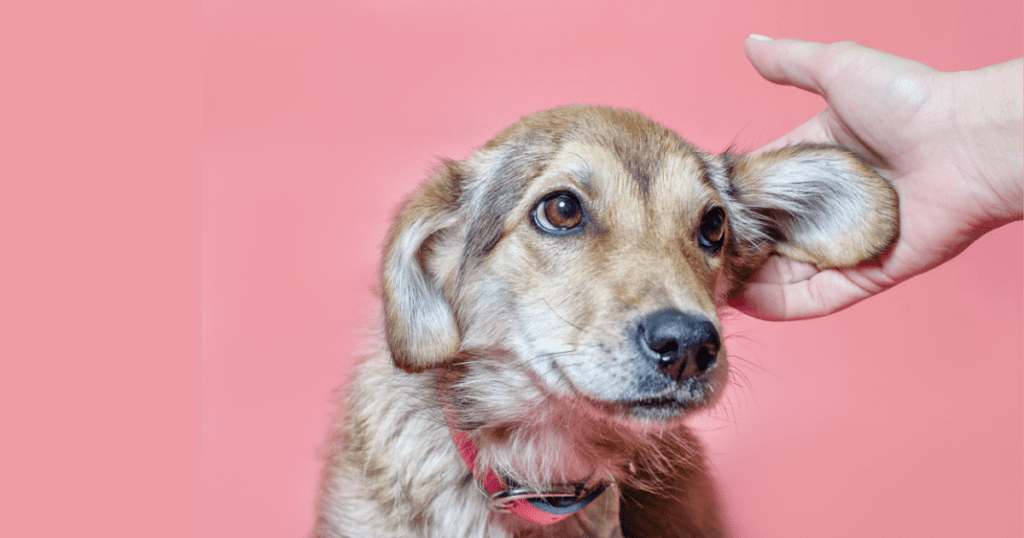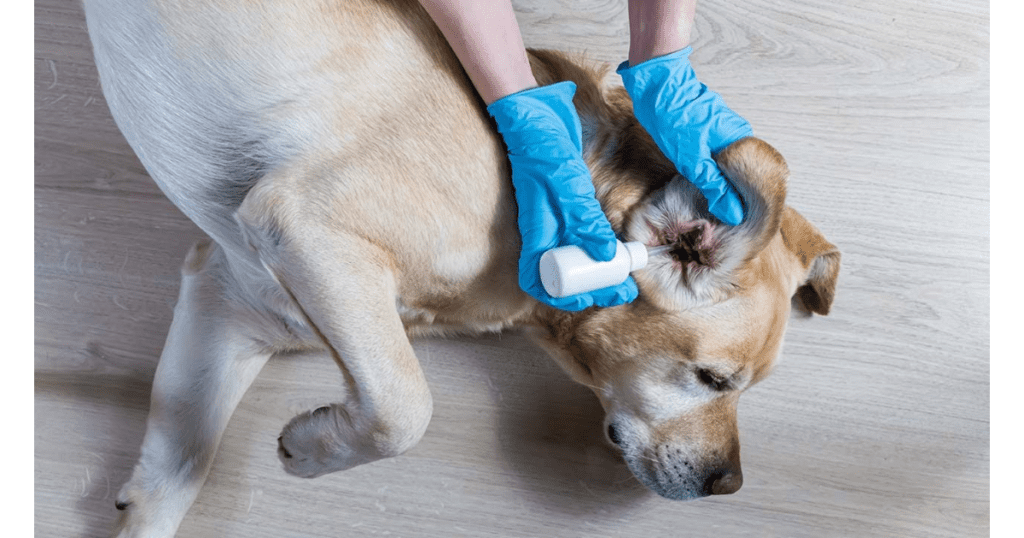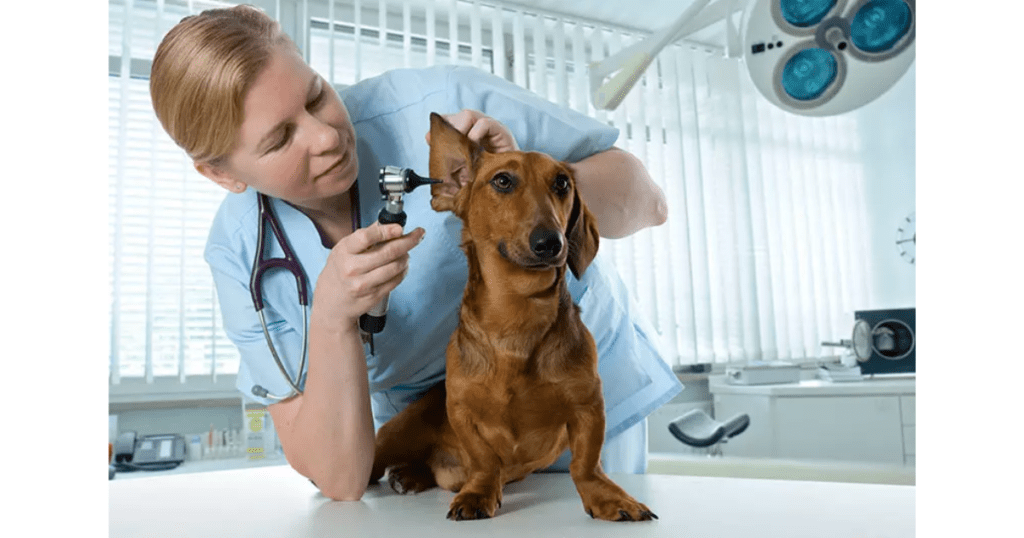Ear infection in dog can be a common and uncomfortable issue that many pet owners face. If your furry friend is exhibiting signs of ear discomfort, it’s crucial to understand the causes, symptoms, and effective management strategies to ensure their well-being. In this blog post, we’ll explore everything you need to know about ear infections in dogs.

Recognizing the Signs of Ear Infections in Dogs
How to Tell If Your Dog Has an Ear Infection
Ear infection in dog can manifest through various noticeable signs. Keeping an eye out for these indicators can help you identify if your furry companion is experiencing discomfort in their ears.
- Scratching or Rubbing the Ears
- Dogs with ear infection often exhibit increased scratching or rubbing of the ears. If you notice your dog frequently pawing at or rubbing their ears against furniture or the floor, it could be a sign of irritation.
- Head Shaking or Tilting
- Excessive head shaking or tilting is another common symptom. If your dog seems to be shaking their head more than usual or holding it at an unusual angle, it may indicate an issue with their ears.
- Unpleasant Odor from the Ears
- A foul odor emanating from your dog’s ears is a potential red flag for an ear infection. This odor is often caused by the presence of bacteria or yeast, indicating the need for prompt attention.
- Redness or Swelling
- Inspect your dog’s ears for any visible signs of redness or swelling. Inflamed or reddened ear tissue is indicative of an underlying problem and may require professional examination.
- Discharge or Wax Buildup
- Keep an eye out for any unusual discharge or wax accumulation in the ears. Discolored or excessive discharge may suggest an infection, while wax buildup can obstruct the ear canal, contributing to discomfort.

Ear Infection in Dog Causes
Understanding the Root Causes
Ear infection in dog can arise from various underlying factors. Understanding these root causes is crucial in effectively preventing and treating ear issues in your furry friend.
- Bacterial or Yeast Overgrowth
- One of the primary culprits behind canine ear infections is an overgrowth of bacteria or yeast in the ear canal. This can be triggered by factors such as humidity, allergies, or a compromised immune system, creating an environment conducive to microbial proliferation.
- Allergies (Food or Environmental)
- Allergies, whether related to food or environmental factors like pollen or dust, can contribute to ear infections in dogs. Allergic reactions lead to inflammation, making the ears more susceptible to infections. Identifying and managing allergies can play a pivotal role in preventing recurrent ear issues.
- Ear Mites
- Infestations of ear mites, microscopic parasites that thrive in the ear canal, are a common cause of ear infections in dogs. These tiny pests can cause intense itching and irritation, leading to inflammation and secondary infections.
- Moisture or Trapped Water in the Ear Canal
- Excessive moisture or water trapped in the ear canal can create a conducive environment for bacterial or yeast growth. Dogs that swim frequently or have floppy ears that trap moisture are particularly susceptible. Drying your dog’s ears thoroughly after water exposure is essential for prevention.
- Foreign Objects in the Ear
- Objects like grass seeds, plant material, or debris can find their way into a dog’s ears, causing irritation and infection. Regularly inspect your dog’s ears for foreign objects, especially if they spend time outdoors, to prevent these issues.
Understanding these root causes empowers you to take proactive measures to safeguard your dog’s ear health.
Ear Infection in Dog Prevention Tips
Keeping Your Dog’s Ears Healthy
Ensuring the well-being of your dog’s ears involves proactive measures to prevent infections and discomfort. Here are some practical tips to keep your furry friend’s ears healthy and happy:
- Regular Ear Inspections
- Schedule routine ear inspections as part of your grooming routine. Check for signs of redness, swelling, or unusual discharge. Early detection of potential issues allows for timely intervention.
- Cleaning Your Dog’s Ears
- Clean your dog’s ears regularly, especially if they are prone to wax buildup or have floppy ears. Use a veterinarian-recommended ear cleaning solution and follow proper techniques to avoid injury. Consult your vet for guidance on the frequency of cleaning.
- Managing Allergies
- Identify and manage any allergies your dog may have, as these can contribute to ear infections. Consult with your veterinarian to determine the allergen and establish an appropriate management plan, which may include dietary changes or environmental modifications.
- Drying Ears After Swimming or Bathing
- Moisture in the ears can create an environment conducive to infections. After your dog swims or bathes, gently dry their ears with a clean, dry cloth. Avoid using cotton swabs, as they can push debris further into the ear canal.
- Choosing the Right Diet for Ear Health
- A well-balanced diet is essential for overall health, including ear health. Opt for high-quality dog food that meets your pet’s nutritional needs. Some dogs may benefit from diets rich in omega-3 fatty acids, which have anti-inflammatory properties that can support ear health.
Incorporating these prevention tips into your dog’s care routine can significantly reduce the risk of ear infections and promote a comfortable and healthy ear environment.
Ear Infection in Dog Treatment Options
How to Alleviate Your Dog’s Discomfort
Discovering that your dog has an ear infection can be concerning, but the good news is that there are effective treatment options to alleviate their discomfort and promote healing. Here’s a guide on how to address your dog’s ear issues:

- Veterinary Examination and Diagnosis
- The first step in treating an ear infection is a thorough examination by a veterinarian. Professional evaluation helps determine the underlying cause of the infection, whether it be bacterial, fungal, or parasitic. A precise diagnosis is crucial for targeted and effective treatment.
- Prescription Medications (Antibiotics, Antifungals, etc.)
- Depending on the diagnosis, your veterinarian may prescribe medications such as antibiotics for bacterial infections or antifungals for yeast-related issues. Follow the prescribed dosage and duration carefully, even if your dog’s symptoms seem to improve before completing the course.
- Cleaning the Ears Properly
- Proper ear cleaning is an essential component of treatment. Your veterinarian will guide you on the appropriate cleaning techniques and recommend a suitable cleaning solution. It’s crucial to be gentle to avoid causing further irritation or damage to the delicate ear structures.
- Home Remedies and Preventive Care
- In addition to prescribed medications, your veterinarian may suggest home remedies to support your dog’s recovery. These may include natural solutions like apple cider vinegar or coconut oil. Implement preventive care measures, such as regular ear cleaning and managing underlying conditions, to reduce the likelihood of future infections.
- Follow-Up Visits to the Vet
- Follow-up visits are crucial to monitor your dog’s progress and make any necessary adjustments to the treatment plan. Your veterinarian may recommend additional tests to ensure the infection has cleared completely and provide guidance on long-term ear health management.
Remember, patience is key during the treatment process, and it’s essential to complete the full course of prescribed medications even if your dog’s symptoms improve.
Remedies for Ear Infections
Ear Infection in Dog Natural Approaches to Supporting Your Dog’s Ear Health
While it’s important to consult with your veterinarian for proper diagnosis and treatment, there are some natural home remedies that may help support your dog’s ear health. Here are a few natural approaches you can consider:
- Apple Cider Vinegar Solution
- Create a gentle ear-cleaning solution by mixing equal parts of apple cider vinegar and warm water. Use a clean cloth or cotton ball to apply the solution to the outer ear and visible parts of the ear canal. Apple cider vinegar has antimicrobial properties that may help control bacterial or yeast overgrowth.
- Coconut Oil Application
- Coconut oil is known for its soothing and antimicrobial properties. Gently warm a small amount of coconut oil and apply it to the inner ear flap using a cotton ball or your fingertips. Be cautious not to insert anything into the ear canal. Coconut oil can help moisturize the skin and alleviate irritation.
- Herbal Ear Drops
- Herbal ear drops, containing ingredients like chamomile or calendula, can be beneficial for their anti-inflammatory and soothing properties. Ensure the product is safe for dogs and follow the instructions provided. Always consult with your veterinarian before using any herbal remedies.
- Probiotics for Gut Health
- Maintaining a healthy balance of gut bacteria can contribute to overall immune health, potentially reducing the risk of ear infections. Consult with your veterinarian to choose a suitable probiotic supplement for your dog’s specific needs and follow the recommended dosage.
- Dietary Supplements
- Some dietary supplements, such as omega-3 fatty acids, can have anti-inflammatory effects that may benefit dogs with ear issues. Consider adding fish oil or other omega-3 supplements to your dog’s diet after consulting with your veterinarian. Ensure that the supplements are safe and appropriate for your dog’s size and health condition.
While these home remedies can offer supportive care, they are not a substitute for professional veterinary advice and treatment. Always consult with your veterinarian before attempting home remedies, especially if your dog is experiencing severe or persistent symptoms. Your vet can provide personalized guidance based on your dog’s specific health needs.
When to Seek Professional Help
Ear Infection in Dog Signs It’s Time to Visit the Vet
While home care and preventive measures are valuable, certain signs indicate that it’s crucial to seek professional veterinary assistance. Keep a close eye on your dog, and if you observe any of the following signs, it’s time to schedule a visit to the vet:

- Persistent or Severe Symptoms
- If your dog’s ear infection in dog symptoms persist despite home care efforts or if they appear to be getting worse, it’s time to consult with a veterinarian. Persistent scratching, head shaking, or signs of discomfort should not be ignored.
- Recurrent Ear Infections
- Dogs experiencing recurrent ear infection in dog may have an underlying issue that needs professional attention. If your dog has had multiple ear infections, your vet can conduct a thorough examination to identify the root cause and implement a targeted treatment plan.
- Changes in Behavior or Appetite
- Any noticeable changes in your dog’s behavior or appetite should raise concerns. Ear infections, especially when severe, can impact a dog’s overall well-being. If you observe lethargy, reluctance to eat, or changes in behavior, prompt veterinary evaluation is essential.
- Head Tilt or Imbalance
- A head tilt or imbalance can be indicative of more severe issues, such as an inner ear infection. If your dog displays these symptoms, it’s crucial to seek veterinary care promptly. Inner ear problems can affect balance and coordination and may require specific treatments.
- Foul Odor or Discharge
- A persistent foul odor or unusual discharge from the ears may suggest a severe infection or other complications. These signs should not be overlooked, and a vet visit is necessary to identify and address the underlying issue.
Remember, early intervention can significantly improve the outcome for your dog.
By staying informed about the signs, causes, and prevention methods, you can actively contribute to your dog’s ear health. If you suspect your furry friend has an ear infection, consult with your veterinarian promptly for a proper diagnosis and tailored treatment plan. Remember, a healthy pup is a happy pup!
Read More: https://drcmpetclinic.com/2023/12/18/hip-dysplasia-in-dogs-causes-symptoms-and-treatment-options/
https://www.akc.org/expert-advice/health/dog-ear-infections/

